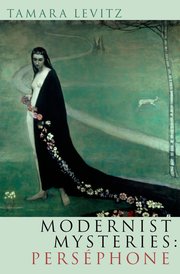 Modernist Mysteries: Perséphone
Modernist Mysteries: Perséphone
by Tamara Levitz
Oxford University Press
680 pages, $65.
IGOR STRAVINSKY’S Perséphone is one of the least understood works in the history of contemporary dance, music, and theater. Tamara Levitz’ Modernist Mysteries: Perséphone presents a hot, bubbling stew of Uranism, naked boys, golden torches, pédérastie, and Sapphist resistance. To say the original production was a bundle of contradictions would be an understatement.
The primary focus of this book is the 1934 premier of Ida Rubinstein’s production. Rubinstein, a fabulously wealthy bisexual Jewish-Russian performer, famously danced for Diaghilev in the Ballets Russes and continued its legacy with her own private company through the 1920s and ’30s. In an interview, Levitz remarked that by “situating Ida in the middle of my narrative, I hope to destabilize the patriarchal framework of modern music history. I also want to recover Sapphic history.”
Levitz’ analysis of Ida Rubinstein’s relationship with Romaine Brooks and her importance as a Sapphic icon are a significant part of the narrative. “I distinguish Sapphic (or lesbian) from homosexual history and describe the separate historical development of each community, thereby countering a current trend in musicological writing to intertwine them.” Consequently, Levitz completely upends our assumptions regarding the collaborations and performances, showing how accepted practices of presenting history can be misleading.
The myth of Persephone is a story of death and rebirth. Hades abducts Persephone, goddess of the spring, and takes her to the Underworld, where she succumbs to his charms and eats some pomegranate seeds. Zeus, heeding the pleas of Persephone’s grieving mother Demeter, sends Hermes to fetch Persephone back. She returns to the earth for two-thirds of the year, reigning in Hades as queen of the dead for the remaining one-third. As a goddess, she now possesses a rare dual knowledge of life and death, her regenerative power metaphorically linked to the image of grain, the seasons, and the invention of agriculture.
Drawing on a rich archive of early eyewitness accounts, primary sources, and other documents, Levitz produces a scholarly and detailed reconstruction. The story of how Rubinstein brought together the talents of André Gide, Igor Stravinsky, French theater director Jacques Copeau, and German dancer-choreographer Kurt Jooss in a collaborative, transnational production is fascinating. This was an undertaking that permitted them to create a hybrid melodrama in which each contributor could articulate his or her most deeply held beliefs regarding religion, sexuality, death, and historical memory in modern art. It is a story about the clash of pederastic desire and Christian redemption that deconstructs neoclassicism as a musical style. The result is a revisionist analysis of modernism in music and theater during the 1930s.
Levitz gives us a ready sense of the complexity and vitality of the period leading up to World War II. With 41 illustrations and eleven excepts from musical scores, she enriches our understanding of Ida Rubinstein’s monumental failure. Her account brims with details that ask readers to lose themselves in its pages as they travel back in time to an era of glamorous æsthetes and flamboyant personalities. Levitz asks us to step back and see the larger picture of this cultural artifact.
In investigating the æsthetic and political ramifications of these artists’ divergent perspectives, as well as the fallout from their titanic clashes onstage, Levitz challenges the notion that neoclassicism was a “reactionary” musical style. In suggesting a more ambivalent and nuanced reading, she reconnects musical neoclassicism with a queer classicist tradition. In so doing, she opens up a dialogue that transports readers right into the controversies, passions, and excitement of the period.
Perséphone is a unique work of art and merits scholarly attention. Levitz’ analysis breaks new ground in shifting the focus from “history” to “memory.” By emphasizing the commemorative nature of neoclassical listening rituals over the historicist stylization of its scores, she argues that these modernists captured on stage and philosophically their simultaneous need and inability to mourn the past. Most significantly, Levitz concludes that modernists like Stravinsky understood neoclassicism not as a formalist compositional approach but rather as a vitalist art haunted by ghosts of the past and visions of the future.
In her revisionist tour de force, Levitz forces us to wrestle with questions of Church and Art and the religious movements of the era, particularly Catholic revivalism. She gives readers a window into the battles that took place between the principals in their struggle to shape the ongoing debates about the body, sexuality, and family values.
In her passionately written and forceful conclusion, Levitz speaks to the need to resist the impulse always to end our research on an upbeat note. Instead, she urges researchers to practice “the politics of neoclassicism,” which she understands as the ability to leave things open to ambiguity. Her book is both fascinating and somewhat disillusioning in describing the constant tug-of-war that went on among the principals. It can also be read as a morality tale that raises significant questions about the value of culture in the U.S. and elsewhere. As a writer, Levitz puts a human face on this production of Perséphone and presents a vivid picture of what artistic creativity is from a scholarly vantage point.
Cassandra Langer, a frequent contributor to these pages, is a freelance writer based in New York City.Modernist Mysteries: Perséphone.





